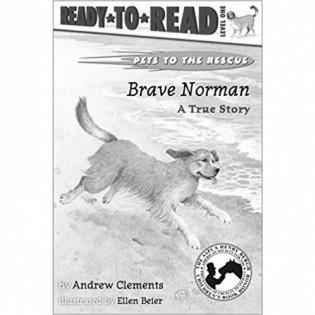Brave Norman Literature Guide
This book tells the true story of Norman, a disabled dog that is slowly going blind. Though Norman can no longer see, his loving family still values him. The other family dog, Lucy, helps Norman get around and stay safe. Norman loves to run with Lucy and his family on the beach. One day at the beach, a young girl is stranded in the water. Despite his disability, Norman swims out to the girl and rescues her. This story teaches children important lessons about the power of overcoming obstacles and heroism. If Norman can overcome his obstacles, why can’t we all?
Before Reading
ASK: Do you know anyone who is blind? Or have you seen a blind person?
SHOW: Look at the picture of the vet examining Norman’s eyes. When a person or an animal can’t see anymore, we say they are blind.
CONNECT: How might it would be difficult to be a blind person or animal? What could you or couldn’t you do? With what kinds of things would you need help? Blind people sometimes get around by using a cane, or sometimes they use a leader dog to help them cross streets, go places, and do things at home.
During Reading
ASK: What problems does Norman have because of his blindness? How does Lucy help Norman?
SHOW: Look at the picture of Norman and Lucy walking together. Norman and Lucy are companions. In what ways do Lucy and Norman help each other?
CONNECT: Blind people can still get around. Sometimes they use a cane or sometimes they use a leader dog to help them cross streets, go places, and do things at home. This dog is called an animal companion. It is the person’s helpful friend. How does Lucy act as Norman’s animal companion?
After Reading
ASK: How was Norman brave?
SHOW: Look at the pictures of Norman rescuing the girl. How would you describe Norman's actions?
CONNECT: Dogs act bravely every day. Many dogs work to rescue people. Some dogs find people who are lost. Other dogs help the police catch people who break the law. Some dogs warn their owners about things like earthquakes or fires. Dogs can be heroes just like people. Talk about heroes you know or have learned about.
Activities
- Raise money for pets with disabilities. Often, owners of pets who need serious surgery or aids to help them live with a disability don’t have the money to make those things possible. Contact your local pet shelter to see how you can help.
- Do you have a dog who is a hero? You can volunteer your dog for pet therapy. Therapy dogs visit hospitals and nursing homes to help make the people living there feel better. Petting animals and having them respond positively to you can make lonely people happy, upset people calm, and sick people hopeful. Learn more about how to get involved in animal therapy.
- Write or tell a story about a pet that is a hero. Draw pictures to illustrate your story. Don’t forget to include what the pet looks like, where it lives, and who or what it helps.
